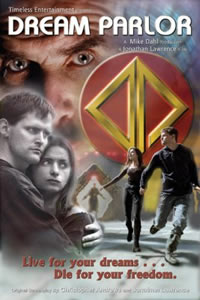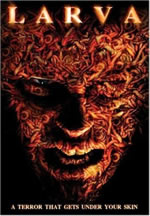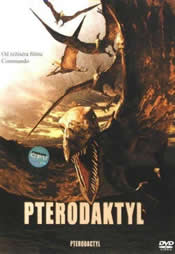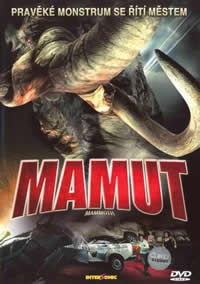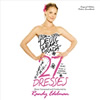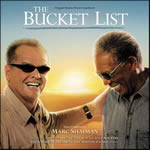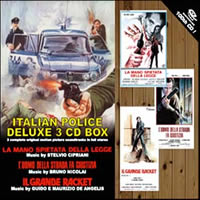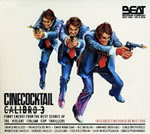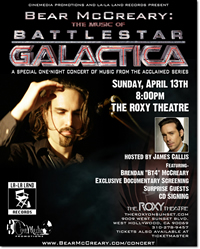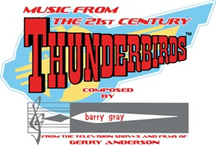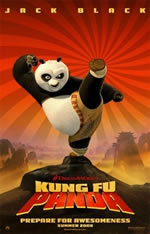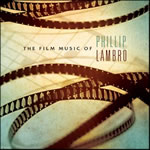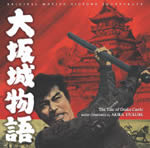 |
March 24th, 2008
The Sci-Fi Channel’s Musical Maestro
By Randall D. Larson
Scoring the Modern B-Movies with John DicksonThis week, Soundtrax presents the first part of a career-spanning interview with composer John Dickson, who over fifteen years has scored some of the best – and many of the worst – movies created for The Sci-Fi Channel. Dickson describes his efforts and intensions behind such scores as Mammoth, Larva, Pterodactyl, Attack of the Gryphon, and others, and discusses the challenges of film scoring amidst the restrictive budgets and deadlines of Hollywood’s modern day B-Movies. Our reviews this week take a considered look at 27 Dresses and The Bucket List from Varese, Siliotto’s latest Under the Same Moon from Lakeshore, Morricone’s A Time to Die, and Digitmovies’ 3-disc celebratory 100th release, The Italian Police Deluxe CD Box. We also gather the latest news and examine the huge and expensive new coffee-table book all about Ennio Morricone. Sorry: we find it a must have!
John Dickson Interview: John Dickson
The science fiction and horror films made for cable TV’s The Sci-Fi Channel may not have the best reputation among genre aficionados, but most of them, in today’s CGI environment, at least competent. Most of them had rapidly gone to budget DVD release, although they can still be found on the cable channel’s rerun list. They are the equivalent of the B-movies of the 1950s, and in many ways they share the cheap production values, script faults, and inconsistent acting of their cousins separated by half a century. But like the B-movie sci-fi and horror films of the ‘50s, when they’re good, they’re very good and may well be regarded as genre classics in another half century.
Like the B-movies of five decades past, there are, if not a studio’s music department full, at least a handful of composers who are specializing in composing the music for today’s low-budget, fast turn-around sci-fi programmers cranked out with regularity for cable and network TV. One of the most prolific of these composers is John Dickson, whose excellent scores frequently belie the faults of their visual counterparts. John’s notable scores for such low-budget fare as Mammoth, Pterodactyl, Larva, Attack of the Gryphon, and others remain quite good, even if the films they are attached to have faded from memory or reside in the previously-viewed bins as Blockbuster or the one-cent lists on the amazon marketplace. But a considered listening to the music from these films reflects the craftsmanship and with which they were created, and the cleverness with which their often miniscule budgets and concise deadlines are overcome to achieve first rate musical scores. Continuing an ongoing working relationship with director Tim Cox, Dickson scored the composer crafted one of his finest and funniest scores for Mammoth – although, as we shall see, the version you’ll hear on DVD is far from what Dickson intended for the original film. In addition to scoring sci-fi channel fantasies, Dickson also composes for the daytime soaps and is also scoring the popular and edgy USA TV series, Burn Notice.
John Dickson grew up in the southwest about 75 miles from Shreveport, Louisiana, birthplace of noted pianist Van Cliburn. It was that moderately nearby neighbor who Dickson emulated as a youth, taking piano lessons and training to do the concert circuit. He played in many local competitions but eventually realized the life of competition and practicing 10-12 hours had its drawbacks. He enrolled in the University of Miami, majoring in commercial music, with an eye on film scoring. “I was a film junkie,” Dickson said. “I loved film music and I loved movies. I knew the music by heart, but it still seemed like it was magic. It just appeared on the film one day. And at Miami I got a taste of what the process was like, and of course as I was studying traditional film scoring, the technology was quickly sweeping most of that out the door, in terms of the technical methodologies for actually scoring a film. So I learned all the click books and the metronome formulas only to immediately have to toss all that out and pick up all the new stuff.”
After finishing school, Dickson worked as a professional pianist and horn player in Houston until the early 1990s when he heeded a friend’s advice that L.A. was really a better place to seek a career in film music. “Early on I got a call from a major orchestrator here in town who I had worked with a little, but he knew me mainly as a French horn player. He had been offered a couple of gigs working for a TV guy that he didn’t really want, because it was represent a sort of step backwards for him, and he said, ‘you know, they’re going to call it orchestration, but that’s not exactly what you’ll be doing, you’ll be doing a lot of arranging, you’ll probably be doing a lot of writing, but it will be a great opportunity for you to see a working staple, to get your feet wet and get some resume going.’
Dickson plugged into that for a while and then started going to student screenings, where he met the new breed of young filmmakers. “The first film I ever did came out of UCLA extension, actually, and it build from there.”
In the first part of this career length interview, which will be concluded in a later column, Dickson describes in depth his musical considerations on his Sci-Fi channel scores and the unique challenges of composing music for modern day B-movies.
Q: Scores for science fiction, fantasy, and horror films seem to occupy the larger portion of your filmography. Is there something that you find, as a composer, unique to that genre that you don’t find elsewhere?
John Dickson: Sci-fi, horror, and fantasy make up a pretty big umbrella. To me those are the operatic genres. You’ve got opportunities, and I try to treat them all like I would if they were all King Kong or all were Star Wars, even though some of these have had tiny, tiny budgets and aspired to be far better that they would ever actually achieve. But you’ve got opportunities for more heroic, grander themes, because you are often dealing with heroic characters. They are much bigger because they’re fantastical, so you’ve got a much greater opportunity for the music to take a thematic shape and then work that into the fabric of the film, and hopefully if the film has any story line at all (and some don’t!) you can develop that. I was a very young kid when Star Wars came out, and more impressive to me than the music itself, which was fantastic, was that on the album John Williams had written a description of his motif and themes, where he really explained, “this is the theme for Luke, this is the theme for The Force, this is Ben, this is Princess Leia, this is the Empire.” Even as a kid to be able to identify the themes and then follow them musically and hear how they’re interwoven was an eye opener for me, as it was for a lot of young composers who liked film.
Even the simplest, smallest of science fiction and fantasy movies gives you the opportunity to work that way, because it’s just a bigger pallet than, say a romantic comedy, which is mostly just somebody talking to someone else across the table. Even though these smaller movies never have the budget that would allow you to write for a real living breathing orchestra, things have come so far since I started that if you’ve got the means and you’ve got the instruments and the technology available, and you know what the real deal sounds like, then orchestrationally the pallet is just so wonderful. Horror is a little narrower bandwidth, I guess, at least a typical kind of horror movie. There’s certain sounds that filmmakers want to hear. You’ve got the rare ones that will allow for something different, because then all bets are off. If you’ve got a genre that’s this broad and has that big a musical umbrella, then it’s really fun to work in that. The first sci-fi I did was a movie called Dream Parlor in 1999, and it never got seen. Jonathan Lawrence did it, and it was such a vast undertaking for one guy working out of a bedroom, early stage CGI, he had no money, but it really had some beautiful moments in it, it just took him forever to finish it. By the time he did finish, CGI had become cheaper and more accessible and it didn’t look as eye-popping anymore. That was the first score that I had a chance to do that had a big movie soul to it, even though it had a very tiny budget.
Q: How do you give something restrictively small the sonic scope it needs to sound bigger?
John Dickson: Luckily, doing commercials for years, and doing some of the orchestration gigs working for bigger films, allowed me to amass the kind of studio you need to not sound crappy on this kind of stuff! If you’ve got a film score lover like Tim Cox, every cue he uses in his temp scores is a $150,000 cue – five times the budget of my actual score! You want desperately to make those guys’ visions come true, and the only way to really do it is to have access to the very best sounds and then be able to take the time to try to make them breathe, and to make them fly.
Q: How challenging is that for you to accomplish?
John Dickson: It means I have to jump into that bottomless gear pit. When I moved out here I had my pencils and score pads and I thought I’ll do quick demos and then people will give me an orchestra and off we go. Occasionally that happens, but I would rather have a great sampled orchestra with some live sweetening – and I always try to use live players on the key parts, if there’s a solo, because you can just never beat that. But I would rather do it that way than have a bad orchestra. I think you gain nothing but having a room full of mediocre players or players that are poorly recorded. I’m not a huge believer in going all over the world to every budget orchestra you can find just because you can get real guys. I would rather invest in the miracle technologies that are happening now and then bring the real people in. In all of these scores, I try to make each one better than the last, sonically, because something has changed technologically, so you upgrade your computer and you get better samples. You never have any time – the hell of these things is they’re very low budgets and there’s no time to do them, either. On Lost Colony, which is the most recent of the sci-fi channel movies that I did, I had eight days from spot to turn it in. That was 75 or so minutes of music.
Q: What’s your technique when you’re dipping into your music samples, and crafting a quasi-orchestral score out of samples?
John Dickson: Because things have improved a lot, even since I started, I find more and more I can write for a sampled orchestra the way I would really write for a real one. What I did in the early days is I would write for the best sounds I had, and would have to live with that. So I would get a project like Alien Lockdown, for instance, one of Tim Cox’s films, that was the first feature I did for Sci-fi Channel with Tim, which I think they now call…
Q: Predator Man?
John Dickson: Yeah, something completely repulsive! And he temped that with all sorts of great stuff. It was very dark and closed, more like an Alien type of movie. I looked at the sample pallet that I had at that time and put my best sounds together first. The strings - what’s got the most sonic weight, what sounds like least reedy and synthy? I listened to the woodwinds that I had and basically passed on all of them for the most part. I listened to the brass I had, I brought in some live brass guys on that, and literally I would make choices based on the pallet I could put together that would be most realistic and would have the most weight. And as my library got bigger and bigger and bigger, and the sample technology has improved, and you have so much more nuance – you’ll never get live nuances from a sample library, I don’t care how good it is; but they get more and more elements of it. Then I start thinking, “ok, I’m going to start writing the score as if I was going to take it and put it on front of 85 players” and then I’ll find what I need, and if I can’t find that great portamento string that I want, or I can’t find quite the trombone articulation that I’m looking for, then I’ll deal with that when I get to it. Then I put a giant pallet together, and if I have no time, like I didn’t on Lost Colony, then I won’t do much paper sketching. I used to write nearly every cue on paper, first, and then start programming. You just don’t have time to do that with some of these things. So, I’ll identify each cue and get very detailed spotting notes from the director, if he’s still on the picture, or from a producer if they’ll come and see me. Sometimes I’m completely on my own. On these small movies, sometimes the director is long gone by the time it gets to me, either because he’s been fighting with the producers, or mostly because he’s gone to another movie. So sometimes I’m left with a temp score that can be anywhere from bad to abominable, and you just have to go on instinct.
If I’m working with Tim and a couple other guys, that’s not the case – we’ll spend hours talking about it – and of course that’s what you want. And as I approach each cue, I’ll find the sound that’s going to get me there quickest. If it’s an action cue, I may start with percussion, and try to hear in my mind how the thematic material will take shape. I’ll always have my themes off to the side, if it’s a thematic movie – some films actually don’t do well with big themes. So you make that decision early on. Then I’ll start with whatever sound I’ve chosen and I’ll write right in the box. I used to think I would never work that way, but even now on larger projects, even when I’ve had a hand in something much bigger, I’ll make a few notes on paper and still start on the sound that will drive it.
Q: One of the things that music has to do in a low budget film is give it the sense of size that the budget isn’t allowing it to do. With today’s technology you can create a score for low budget films that has that sense of size and scope and dynamic on a keyboard based system. What considerations must you take to do that?
John Dickson: I always try to treat that very judiciously. I’ve worked on short films where they want this colossal, cinematic epic orchestral thing, and you have to be careful, because you can fake it reasonably convincingly, nowadays, but you can also overwhelm a film. Certain films just cannot support the weight of a giant orchestra crashing around in it, they just won’t hold up. So I always look at the intent of the film and then decide, like Larva, for Tim. That had a much smaller pallet, musically. There are a couple scenes in there, toward the end, where it inevitably gets bigger, because that’s the big action scene and the closer, but in general that was a much smaller pallet because that was a more intimate film. I decided to go very Goldsmithian on this, if I may, because Jerry was a master of knowing when to get out of the way and let orchestration do it, when to let textural musical sound carry the weight, and hopefully you’ve got a sound effects pallet that you can work in concert with (I’ve got a number of friends who mix sound, and we’re always talking about how sound and music can live in harmony and not constantly be an either/or kind of thing). So Larva had a smaller pallet because I felt a big thematic score would have been too much. There were themes in Larva, but they were very subtle and not very traditional. On the other hand, Attack of the Gryphon, you’re fighting dragons and gryphons and you’ve got armies amassing on the field and it’s this epic thing – although I should point out in Gryphon that if you get too epic around ghastly dialog, you can actually point to the fact that the dialog is lightweight and a little bit impish, and you’ve got this music crashing around. So I think you have to be careful because you can always have a 100-piece orchestra and a 100-piece choir if you’ve got the samples, but that’s not the question to ask. Some films can’t take that. Alien Lockdown is another example, it had a more intimate score, very dark – tubas, bass clarinet, contra bass bassoon, the low percussion, and it didn’t get big until the film needed help, because visually they could only do so much, and then the music can kind of step in and add some gravitas. So I definitely am very wary of using everything you’ve got in the box just because you’ve got it.
Q: Use your tools appropriately based on the dramatic needs of the film in question.
John Dickson: Yeah. And it’s also based also on how it looks. If it’s a big epic intent but it’s all two-shots, without any scope, visually, then you probably can’t go all out – unless they say, “look we temped it with Gladiator or Quo Vadis,” and then you just have to go that route and hold your nose and do it!
Q: One of the early shorts you did for Tim Cox was Man With No Eyes, which was a sci-fi Western, a genre-combination I always find very appealing. How did you match this genre-bending with your music?
John Dickson: A little bit of Spaghetti Western with a sci-fi/horror texture. That’s a perfect example of a movie where I went small, with the orchestra. I had a little live French horn and live guitar. So it was sort of a Spaghetti Western pallet in terms of the use of the guitar, light strings, and airy textures, mixed in a few spots with more sci-fi elements. It’s not action-heavy, although there are a couple of fights. The two main characters are aliens but they’re standing in this dusty 19th Century Western town and they’re fighting with these weapons that appear and disappear as they’re utilized. The Stranger’s got a boomerang that he throws that opens up with blades all around, slits all the bad guys’ throats and that retracts and comes back to him…
Q: Sweet!
John Dickson: I used a choir for that moment! Just on a cluster, for the moment of that scene. That was definitely a score, despite Tim’s wanting more music, where I thought either leaving it out or leaving it very sparse would actually make the film sound bigger. They had these nice looking crane shots and things you don’t always get in a short film. I tried to think, if this were a young Spielberg doing this film, he would want to have music, but dialog is king and attitude is king on the screen, so he would want to play it under a lot of distant string pads with maybe just a couple of guitar notes doing an ostinato type of thing, and not play the horror elements with a very strong hand, until right at the end where things come to a head. It’s a great little movie. That was the first thing I did for Tim, and that movie got Tim connected with Sci-fi Channel.
Q: One of my favorite cues in Larva is during the early scene with the cattle ranchers and the meat market guy are having this BBQ, and all the sudden you’ve got this eerie tone that morphs out of the bluegrass when the camera pulls away from the raw meat and we see the larva wriggling away. It infects this snappy, bluegrass festival, this happy occasion, with this ominous little tone of menace and danger. Goldsmith did this a lot also, imposing a subtle counterpoint tonality that wafts up and turns an event on its head, and what was a cheerful moment suddenly portends of something bad happening.
John Dickson: That was a perfect example of being able to orchestrate the way you would really do it if you had an orchestra. I’ve always liked those little moments to be very subtle. I’m not a big fan of gotchas, because if you fill a score full of on-the-nose kind of moments or you telegraph a lot of what’s going on, it will stop working. There is a scene or two in Larva that I’m using the music to telegraph a little bit what’s coming, but on the other hand there’s not a lot of transitions in that movie to build a lot of tension before something really horrible happens. The fine line on that film is knowing when to do that. Larva actually has, woven into the thematic textures, even more subtle things where just some of the chord structures are a little off, and you get a sense that something’s wrong.
Q: You also mentioned in your featurette bit on the Larva DVD that the score had a jazziness to it, although it’s not jazz, and you’ve got timbres that were reminiscent of 70s cinema… Can you elaborate on this a bit?
John Dickson: The main thing that gave it a bit of that 70s feel was the use of vibraphone, which is not something you hear often at all. I chose that mainly because at this budget level when I’m not going to get a lot of live players, a vibraphone is a very, very convincing sample these days. It’s a percussion instrument and there’s not a lot of colors you need out of it, so it was a wonderful texture that I could absolutely sell as authentic. In my mind, I heard some of the scores on some of the great 70s TV series, like Hawaii 5-0, which used very small ensembles and heavy use of rhythm section. You could have anything if you had a rhythm section. You can have a love theme, you can have an action cue, you can have anything. You can have the rest of the score not doing anything jazzy, but the vibraphone will convey the jazz textures brilliantly. That was really the only thing that I pulled – there’s no guitar and no saxophones in that score, I’m not using any of the other things that would make you think of jazz, it was just basically use of vibes and a little use of rhythm section that, because Tim was definitely trying to go for a bit of a retro feel as well.
Q: Your score to Pterodactyl drifts from a very melodic main title theme to some very interesting percussion work as the action and the creatures build up in the film. What was your approach to that particular film?
John Dickson: That was a film that had virtually no temp score. Temp scores are sort of a hot and cold thing for all composers, as you know. It’s a great way for a non-musical director, which is 80% of them, to communicate what they want without the burden of trying to be musically specific when they can’t. But you know what happens if they fall in love with what’s there, then you’re stuck. And on a small budget film, if they’ve fallen in love with 12 million dollars worth of score, then you’re facing this huge battle because what you do for them, sonically, will never sound like what they had. Pterodactyl had almost none, and it was another score that had to happen really fast. Mark Lester’s films come to you when they’re ready for music, and I mean they’re ready! So they were getting close to the dub stage and I had to work fast. There were some nice scenery shots laid into that picture, and again it’s a film that’s got a lot of humorous throughout . Mark just wanted it to sound like a big movie. He’s done big movies, so he wanted it to have some suspense and some weight, so I thought, here’s a film that’s got the intent, at least, to be large. You’ve got dinosaurs flying around, you’ve got big scenery moments, and you’ve got a director who certainly has directed an action sequence or two in his career, so even short on resources, there are enough set pieces to allow me to do some cool stuff.
You’ve got a bit of a military angle on it, and of course it’s very easy then to go to percussion when you’ve got that, but percussion on a small film is also an easier sell, sonically. You can really fill up the screen and do some cool stuff with one live player and sampled instruments. You’ve got an almost infinite pallet when you start breaking out the percussion toy box, so you can drive the ship really well with that underneath. Then I played some pretty harmonically out-there orchestral stuff. This wasn’t a movie that had big themes. Pterodactyls really don’t need a theme, anyway – they’re not given a personality, you don’t get to know them, they‘re just… hungry, basically. There wasn’t much tension and release, once you see them it’s one chase after another, so the Jaws moments aren’t really there. There’s a scene in the woods, when they discover the pile of pterodactyl pee on the side of the tree, where I wrote one of my favorite cues in the film, it’s just harp and strings; it is a bit of a Jurassic Park thing, because they haven’t seen the dinosaurs, they’ve only seen the traces. So that was kind of my thought with that, to make the big orchestra the big ticket item, but don’t make every chase the Fight for the Death Star, because there’s so many of them. So you start with a smaller pallet and use as lot of percussion to drive the early ones, because there’s so many action scenes, and then you get the last big one with the soldiers and the final deal, and that’s where you haul out the rest of the orchestra and play the heroism of the final scenes. That’s when the horns come out and the thematic material comes out. You have to pace the score even if the pacing of the film is a little frantic. I think you can add more of a ramp if the music doesn’t go all out from the start.
Q: I want to ask about Mammoth, which is one of my favorite scores of yours, really a nice full-blooded score in many ways.
John Dickson: That’s working with Tim again, so it automatically is more important to me, right off the bat. Tim is one of my true collaborators who I love working with. He puts more thought and effort into what he’s doing and so I always feel I’ve got to raise the bar when I work with him. Now the DVD release of Mammoth represents a dramatically altered score, to satisfy the market for the buyers of that film. The original film as it aired on Sci-Fi channel was very tongue-in-cheek, it was very spoofy. I got a call after Mammoth was done and the Sci-Fi channel version was in the can. The foreign market bought Mammoth as a horror movie based on the concept of it being a scary mammoth movie. But Tim made a poke-in-the-eye mammoth movie.
The first thing that Tim told me was: Hank Mancini. “I want to know what you think Henry Mancini would do if he were going to do a horror movie.” Because Tim not only knows who Hank Mancini is, he knows his music, which is the brilliant thing about working with Tim, he’s an aficionado of film music . So I said, Oh, you mean like “Man from U.N.C.L.E. Goldsmith kind of stuff ?” He said “Yes! That’s what I want! Pink Panther kind of, and when you see the movie you’ll see how it would work.” So I picked up Man from U.N.C.L.E. and a few other scores from that era to listen to. It was orchestral but more like of big band with strings. The opening title still has sort of the flavor that I had gone for. But the title music on the dvd is minus an element – I had a 60s surfer guitar going under the whole thing, and it’s gone. I had to take it out for the darker version. Every time you see Vincent driving, walking, doing whatever, in the early going of the movie, I’ve got clavinova, which is one of the keyboard instruments that Mancini used in all the Pink Panther films. I go totally Peter Gunn for the two Men in Black agents. I love the scene where the two agents come to the door and Tom Skerritt and Vincent have that wonderful banter. I scored it with acoustic bass, a trombone quartet and four bass flutes, and it’s gone. I was really disappointed when I saw that this was the version they put on DVD, this is the one that I had doctored because they said, “look, we’ve got to have a horror movie, so anything you could do to de-funny it, you’re going to have to take it out.”
The scene of them in the lab where they discover it’s a probe and you see them dancing around with the fire extinguisher. Tim had me go complete Carl Stalling, “I want cartoon music.” But for the foreign version I took all of that out. Tim’s original vision for the DVD was that they would put both versions on it. They would put the original Sci-Fi Channel aired version because it has the funny moments that he liked, and then they’d put the other version to show, kind of effectively, how you can unfunny a film changing nothing else but the score and really make it sort of darker. As the film progresses, the score becomes more what it was, because now you have to bring the horror elements in
Q: You also used Theremin or a Theremin- sample in the score.
John Dickson: There was Theremin all over it. Most of it is gone now. What the film’s strengths or weaknesses were, some it worked some of it maybe doesn’t work, but it was what he wanted. I loved doing that movie. I had so much fun.
Q: You mentioned Gryphon earlier. This was a kind of period, high-fantasy score. The CGI isn’t entirely convincing, and the dialog isn’t entirely convincing, but at the same time you were clearly in an element that allowed you to compose a wonderful epic-styled fantasy score…
John Dickson: That’s one of those where you have to look at what they wanted to do and score it that way. And, again, this is a perfect example of a film that I got pretty early on. My cut of that film had no gryphon in it at all. It had a couple of computer animatics and wireframes, but half the time you’ve got a grip or an assistant holding a Styrofoam head up in the air, just to give the actors something to look at. So when I scored the film I hoped it would be like if I scored Dragonquest. In my mind, I went “alright, they want this to be a big, epic historical sword and armor flick, the production design is in some way pretty good, they had decent looking costumes and nice castles and some good external shots. I talked with Andrew [Prowse, director] and found out what he would like to have happen in terms of the emotion. He was trying to make the tension between Lapaglia’s character and Amber’s character real, since they’re like Romeo and Juliet types, warring families coming together. I tried to play so each side had some thematic presence, and of course the wizard’s got his textures, I didn’t really write a melodic theme for him, I went more with sort of an orchestrational approach when he was around, and then used that with the gryphon was around as well, and that was mostly non-tonal.
Q: It was effective to tie him and the gryphon together, since they had this mystical bond anyway.
John Dickson: Exactly. So I went with a similar pallet for the two, one has just got a little more activity once it’s flying around killing people. Then I will spot that based on their notes, I’ll get my high points in the dialog, put all that in Performer, and then shrink the whole picture down to the size of a postage stamp. In the case of this film, because looking at some of the images here would actually have been counter to writing a good score! So once my notes are there and I knew what I wanted to do musically, I didn’t pay a lot of attention to what was on screen after that point with a lot of this music, because there was just so much of it not there! I find on these movies, especially, if there might be some flaws in the animation or if things might have gotten a little silly in places, if the music is picking up all the action and kind of dipping and scooping with it, you just make it worse. So with this film I played attitude. We’ve got a nice looking castle, we’ve got a thing flying around that wants to kill people, we’ve got guys in pretty decent looking armor, I’m just going to play something that feels important and has got some gravity to it.
Interview to be concluded in a later column.
This Week’s Recommendations
Randy Edelman’s latest tuneful romantic comedy score, 27 Dresses, has been released by Varese Sarabande. The film is another version of the always-a-bridesmaid-never-a-bride chestnut, this time with Katherine Heigl as a chronic bridesmaid who wonders what to do about being one when her sister marries the man she's secretly in love with. Ho hum. Edelman has a fine gift for light melodic orchestral music with a snappy pop-tune hook, and 27 Dresses is alive and well with his very likeable brand of melodious romantic tunesmithage. His main theme is a slightly wistful, slightly regretful mélange of piano and strings, all very delicate and light. The score grapples purposefully with Heigl’s heartstrings, accentuating her heartbreak, her discontentment, her hopefulness, and her eventual winning love in the end, and Edelman’s music escorts Heigl down numerous aisles with honesty and affection. There are a few urban pop tunes, like the cool vibe of “Streetwalkin,” some poignant orchestral yearning in “La Vie En Ring,” and a very classical scherzo that is far removed from the style of the rest of the score for its the final track, “Anotha Cuppa Tea,” but for the most part the 27 Dresses score does just what it needs to do in a film like this – sound pretty, accompany the film’s laughter and tears, and resolve well. It’s an undemanding but very likable and effective score.
Carlo Siliotto’s sublimely melodic score for Under the Same Moon (La Misma Luna) has been released through iTunes by Lakeshore records. The 2007 film, directed by Patricia Riggen, tells the parallel stories of nine-year-old Carlitos and his mother, Rosario. In the hopes of providing a better life for her son, Rosario works illegally in the U.S. while her mother cares for Carlitos back in Mexico. Unexpected circumstances drive both Rosario and Carlitos to embark on their own journeys in a desperate attempt to reunite. Along the way, mother and son face challenges and obstacles but never lose hope that they will one day be together again. Siliotto’s score enriches Riggen's heartwarming family story with a warm wash of orchestral melody that signifies the bond between Rosario and Carlitos, while also emphasizing the story’s ongoing sense of danger as well as the film’s social subtexts (which subtly comment on the much-debated issue of illegal immigration). Rather than associating his score with Latin American music (with a few exceptions, such as the Hispanic vibe of “Tienes Razon”), Siliotto, whose melody-based scores for historical dramas like Julius Caeser, David, and Esther as well as actioners like The Punisher and Nomad: The Warrior, have really impressed me, provides a fairly ethnic-free score that emphasizes human interaction and family bonds despite cultural, geographic, or national boundaries. Through a lush and clear-toned texture of strings, flutes, acoustic guitar, and accordion (the score’s sole unusual instrumental flavoring), Under the Same Moon evokes a splendid atmosphere of vivid passion and familial joy; “El Sacrificio De Enrique” propels the score’s overall poignancy into an urgent, frame drum-propelled action cue, while “El Semaforo” closes the score with an air of pleasing resolution.
After spending a while involved in Broadway and Hairspray, Marc Shaiman makes a pleasing return to filmscoring with The Bucket List, his affectionate score for Rob Reiner’s amusing look at two terminally ill men who escape from a cancer ward and head off on a road trip with a wish list of to-dos before they kick the bucket. Shaiman’s eloquent, slightly mischievous, and thoroughly full-of-life music tinges his contemporary pop style with a slightly jazzy tonality of nostalgia. The music is wistful with an uncomfortable prognosis facing both men, but filled with the satisfied dignity of lives well spent and recent moments well chosen. The score is honest and emotional; like the film its humor derives from the gusto with which one faces life – and its inevitable cessation, and by embracing this discomforting topic with honest integrity, courage, and satisfaction, both film and score share a remarkably unique emotional bond with the rest of us. Shaiman’s score is well conveyed and well preserved on this album. Because the score is quite short – only a dozen tracks, and two of those are source cues – Varese Sarabande has filled out their CD soundtrack with eleven selections of Shaiman performing selections from his filmography on piano – including a thoroughly wonderful variant on the Goldfinger (aka “Printmaster”) song in which he laments the studio practice of making final sound mix modifications, often at the expense of score, via the Printmaster machine. Because the score is rich in piano (performed by Shaiman for the soundrack), the album morphs seamlessly into these solo piano renditions, tunes from The American President, City Slickers, Sleepless In Seattle, The Addams Family, South Park: Bigger Longer & Uncut, and a few others. It’s a nice intimate visit to Shaiman’s music room enjoying a private performance. In keeping with the intimate nature of the recording, the expanded liner notebook contains a long and affectionate tribute to Shaiman from film music agent extraordinaire and friend Richard Kraft.
My web hosts here at BSX Records have released the premiere CD soundtrack to Ennio Morricone’s A Time To Die, a 1982 World War II drama previously released only on LP by Cerberus Records in 1984. It has my high recommendation not on their behalf as much as because it’s really an excellent score, too long unavailable. Set in the final days of the Second World War, the film, directed by Matt Cimber from a story by Mario (Godfather) Puzo, tells the story of Michael Rogan, a young American revolutionary (Edward Albert, Jr.) who loses his wife and comrades in a Nazi raid on her village. After being left for dead by the cruel Colonel (Rex Harrison) responsible for the massacre, Rogan goes on a quest for vengeance after the War is over, killing off his former German captors, one at a time. Morricone’s score is richly textured, featuring harpsichord, and carries a tone of relentless melancholy befitting the story and its situation. A primary theme for flute over piano and strings emanates from the lively keyboard opening to capture an elegant and sorrowful melody that conveys the protagonist’s pain while also delineating his conviction to carry on his cruel task.
Composed during the period in which Morricone scored Butterfly and Hundra (both for director Cimber), Le Professionale, Nana, and the epic television miniseries, Marco Polo, A Time To Die shares something with The Scarlet and The Black, 1983’s WW2 TV-movie about the Vatican and the Nazis, which is also built from strident notes from keyboard. “Recitation On An Ancient Harpsichord” is a remarkable track with harsh arpeggios of harpsichord and oboe (or clarinet?) splayed over a strident and active bed of winds and strings. “Tzigane Style” is a cool solo violin piece over tremolo strings and rapid fingers of harpsichord rustling in the background. “The Third Day at Dusk” proffers a melancholy yet very pretty woodwind melody over strings and piano. A track called “Sicilian Tension” features jews harp and ocarina over harsh low reverbed piano pounds and a sustainment of strings, constructed; another excellent tension-filled track is “Torture And Memories,” presumably for a scene where Albert recalls what happens to his wife, building a strong degree of apprehension through recurring 3-note woodwind cries over sustained strings, wandering piano notes, low moans of cello, and ominous, brutal notes from harpsichord, its rhythmic measures displayed over an underlying, somber, string sustainment right out of Battle for Algiers. “Seven Graves for Rogan” morphs into the kind of militaristic cadence punctuated by winds and strings that have been characteristic of Morricone’s war movie scores from Gott Mit Uns and Mussolini: Ultimo Atto, a driven goosestepping martial motif bristling with snare and shrugged-shoulders; “Invasion” replicates the same sensibility earlier on. “The Girl from Munich,” represented in two variations on the album, is much like the Gott Mit Uns piano theme, a slow keyboard melody performed strictly and somberly over strings, vibrant in shades of regret and hidden anguish. The album closes with the pretty Sicilian tune, “Wedding Feast in the Fields.” As the masters no longer exist, BSX’s release has been mastered from mint stereo copies of the original Cerberus Records vinyl release; the music sounds very clean and clear-toned, though. A Time To Die is a limited edition release of 1500 units. The 4-page CD booklet contains a fairly generic bio of Morricone but no valid background data about this score.
Digitmovies celebrated its 100th release with a special 3-disc/3-score set called Italian Police Deluxe 3 CD Box. The set comprises three terrific scores from the mid 1970s, each presented on its own cd – Stelvio Cipriani’s La Mano Spietata Della Legge (The Bloody Hands of the Law 1973), Bruno Nicolai’s L’Uomo Della Strada Fa Giustizia (Manhunt In The City, 1975), and Guido & Maurizio de Angelis’ Il Grande Racket (The Big Racket, 1976). Cipriani’s score is quite eloquent, a little more melodic and a little less punchy than most scores for these Eurocop thrillers of the 70s. The score opens with an effective rhythmic montage, strings over a guitar combo and drumset. It’s slightly reminiscent of Morricone’s The Sicilian Clan (1969) in that it has a similar vibe and sensibility. “Caccia Urbana” is a cool urban vibe for low flutes, rhythm guitar, and piano over a contemporary bongo and tom-tom beat, while “Con Sentimento” is a quirky tune for keyboard, really a nice track, and “Violenza” is a fast-paced jazzified track for brooding and piercing flutes and random strums of guitar over a rapid bass and drum riff. Aside from these tuneful diversions – and the more pervasive pop idioms of “Con Sentimento (bossa)’s” trendy lounge bossa nova and “Relax in the Swimming Pool’s” lounge jazz/pop – Cipriani’s score is a monothematic composition whose single theme is morphed into all manner of guises – a rhythmic love motif in “Momenti Per Amare” and “Attimi D’Amore,” a more austere romantic variant for solo wind in “Amore per Lei,” solo guitar in “Amore per Lei (chitarra”), and piano (“Una Giornata Triste”), and a couple of other renditions. It’s a nice score.
Nicolai’s Manhunt in the City, from noted giallo (Spasmo) and police (Milano Odia: la polizia non può sparare) director Umberto Lenzi, opens with a pleasing jazz piano piece, joined by rhythm section. The score retains this tonality throughout, a primarily jazz-based rhythm and riff score that fits the film’s urban grittiness. The score’s main theme (“L’Uomo Della Strada”) is reprised frequently throughout the score, while a variety of action and suspense cues, drawn from contemporary jazz riffs, abound. A delicious romantic theme is supplied via “Un Uomo Innamorato,” a persuasive melody for soprano sax over guitar and drumkit. “La Citta All’Alba” is an especially good progressive jazz cue, developing into a determined riff for piano and rhythm section with a very pleasing descending rhythm beat from trombone; the motif recurs at the end of “Amore E Violenza.” “La Vendetta Di Un Cittadino” captures a similar progression flavor, moving from rhythm to aggression to suspense and back. “Attimi Di Tenerezza” is another pleasant melody, horns over piano and electric guitar, that segues into jazz riffing from marimba and percussion. “Pensando A Lei” and “Amore Nei Suoi Occhi” are both a gentle romantic melody for piano and jangling guitar; the latter is interrupted by the piano of the main melody and becomes a strident rhythm section action cue for its second half. “All Night” is a strong melodic rock and roll guitar instrumental. Even in its recurring riffs and motifs, Manhunt in the City is a fresh and continually interesting score; it is based more on a standard jazz idiom than on the more characteristic melodies and instrumentations we’ve come to expect from Nicolai, but it’s an exceptional score in its own right. Digitmovies’ 21-track CD is the first appearance of this score on disc; only a few tracks were previously included on an earlier promo compilation from CAM. An alternate version of the End Title cue is included as a bonus track.
As for The Big Racket, that title also describes much of the music, as far as I’m concerned. I’ve never been impressed by the De Angelis brothers, and most of their music here is just a raucous intensity of noise, nondramatic, nonprogressive rock and roll riffing. Not that there’s anything wrong with rock and roll film music – it’s been done and I’m a huge rock fan anyway. But the De Angelis approach to film music, especially as evidenced here, is to start the harsh strumming at Bar 1 and keep it going without much variation or development or interest until the last Bar. This stylistic approach, coupled with the nightmarish hallucinatory atmospheres of tracks like “Hallucinations” leaves little for me to appreciate on the third disc, nor does it do much in terms of developing drama or enhancing cinematic emotion. “The Big Racket, Reprise 1” is somewhat more tolerable and less grating, but even it becomes fairly monotonous. “In Trattoria” is pleasant enough set-dressing for a scene’s locale. This would have been a perfect set had a different score by Morricone or Micalizzi or Trovaoli or somebody with a finer sense of musical drama been included instead; as it remains, Digitmovies’ Police Box makes a splendid 2-CD set to be treasured. Just leave the third disc in the box.
Speaking of Italian police thrillers, Beat Records has issued, as their third volume of Cinecocktail compilation soundtracks, Calibro 3: The Best Scores of the Violent Italian Cop Thrillers. The package contains a CD with 22 tracks, several never before released, from such composers as De Masi, Trovaioli, Morricone, Cipriani, Micalizzi and others, along with a DVD containing a way cool 1-hour documentary about these types of films which is very enlightening. This is essentially a jazz compilation, as most of these tracks are rhythmic or dramatic jazz cues composed for a dozen Eurocop movies of the 70s. The hour’s worth of tracks provide an excellent overview of the music of these kinds of films. Despite what I said a couple of paragraphs ago, Guido & Maurizio De Angelis provide two pretty good tracks here, coolly subdued and low-key rhythmic tracks from Roma Violenta and La Polizia Incrimina Le Legge Assolve. De Masi’s “The Blue Boat,” a terrific deleted jazz track from The Big Game (recently released in full, with “The Blue Boat,” by Chris’ Soundtrack Corner of Germany; reviewed in my Jan 14th column). Trovaioli’s “Tony’s Magnum” from Blazing Magnum, released in whole by Beat earlier this year, is another outstanding jazz track, as is the same films gently rocking love theme “Louise.” Gian Franco Plenizio and Enrico Periannunzi’s title tune from Liberi, Armati, Pericolosi, is a great title theme – contempo 70’s pop/rock with a touch of lounge jazz vibe that really swings. Another track from this score, previously unreleased (the former track was included in a Tomas Milian book/cd set last Nov.), is equally likeable. Franco Micalizzi’s location-setting “Naples’ Alley” from Napoli Violenta, released in whole by Beat a year ago, is a catchy mandolin cue that drips of Naples; the same composer’s “The No-Peace Pursuit” from Italia A Mano Armata is a hard-edged rocking number that sets a Schifrinesque contemporary vibe to this film, while his charming ‘An Innocent End Title” from Napoli Violenta is a mix of catchy vibe and orchestral eloquence. The film’s End Title song, “A Man Before Your Time,” is an excellent early 70s folk-pop song. Lallo Gori’s title music from A Tutte Le Auto Della Polizia retains a cool rock band vibe accentuated with jews’ harp, plunking out a regular twanging beat; and the included track from Gori’s Italia: Ultimo Atto? is equally grabbing. Morricone’s Main Title song and his oppressive chase theme, “Repressione di Stato,” from Il Prefetto Di Ferro are included also. The DVD that comes with the set consists of a concert in honor of Francesco de Masi in which Franco Micalizzi conducts a small ensemble through several pieces of music from de Masi’s police thrillers interspersed with interviews with half a dozen composers, musicians, and directors who discuss working in the Italian film industry of the 1970s. The documentary, directed by Philip Mason, is subtitled in English. Unfortunately the live orchestra scenes didn’t have sufficient sound and are overdubbed with tracks from the soundtrack albums, which makes the live playing look a little awkward; but it works out ok in the end, and the document is a fascinating glimpse into Italian films and film music, cop thrillers and other genres, of the era.
Film Score News
20th Century Fox has confirmed to Upcoming Film Scores that Brian Tyler has been hired to score the studio's upcoming sci-fi action spectacle, Dragonball, for release in April, 2009. James Wong, who previously worked almost exclusively with the late Shirley Walker (Final Destination, Willard, Black Christmas), is directing and has adapted the screenplay from Akira Toriyama's comic about a young boy who sets out to gather all seven Dragon Balls to save the world from an evil despot. Justin Chatwin stars as the boy, Goku, and he is supported by a cast including Emmy Rossum, James Marsters, Yun-Fat Chow and Jamie Chung. Brian Tyler recently scored Fox's Aliens vs Predator - Requiem, and his other recent action credits include Rambo, War and Bangkok Dangerous.
Bear McCreary will conduct his Music of Battlestar Galactica in a live performance on Sunday, April 13th, at the famed Roxy Theatre on the Sunset Strip in Los Angeles. James Callis, the show's enigmatic Dr. Baltar, will host the evening. “This concert will eclipse our 2006 performance in every way,” said McCreary. “Our ensemble includes a full rock band, ethnic soloists, vocalists, strings and all the taikos and exotic percussion that create the signature Galactica sound. We will perform selections from the first three Battlestar Galactica soundtrack albums, including our searing rendition of Bob Dylan's classic All Along the Watchtower, from the third-season finale.” The evening will also premiere an original documentary about the making of the Battlestar Galactica score, and end the night with a CD signing. This is a unique opportunity for fans, cast, crew and musicians to come together and celebrate this incredible show. For more detailed information, check out Bear’s blog at http://www.bearmccreary.com/blog/?p=263. Tickets are on sale now from Ticketmaster.
For those readers in England, you will enjoy a concert of your own on Saturday, November 8th, a the Royal Festival Hall, The South Bank, London, where the Barry Gray Centenary Concert will take place in honor of the composer of Thunderbirds, Fireball XL-5, Supercar, and so many other wonderful British sci-fi television. The Philharmonia Orchestra will perform together with guest musicians, including composer-pianist Crispin Merrell (Space Precinct, Lavender Castle and New Captain Scarlet). Ralph Titterton, restorer of the Barry Gray archive and co-producer of the Barry Gray original soundtrack CDs, and Cathy Ford, Barry Gray librarian; researcher and biographer, have joined with composer, conductor and arranger Francois Evans to produce a concert to celebrate the centenary of Barry Gray’s birth.
Net proceeds will be donated to The Cinema and Television Benevolent Fund.
Tickets will be on sale at the South Bank Centre at www.southbankcentre.co.uk.
Reference sites:
Barry Gray Biography (232KB):
http://www.lampmusic.co.uk/downloads/barry_gray_biog.pdf
Reflections on Barry Gray (4.7MB):
http://www.lampmusic.co.uk/downloads/reflections_on_gray.pdf
Dreamworks Animation’s upcoming Kung Fu Panda will get an original score co-written by Hans Zimmer and John Powell. This marks the first collaboration in eight years between the composers, who worked together on Dreamworks' The Road to El Dorado and the action thriller Chill Factor in 1999. Kung Fu Panda is directed by Mark Osborne and John Stevenson and features the voices of Jack Black, Jackie Chan, Dustin Hoffman, Lucy Liu and Angelina Jolie. The film, which tells the story about a lazy panda who is forced to turn into an action hero, is scheduled to premiere on June 6.
- via upcomingfilmscores.blogspot.comOscar-nominated composer James Newton Howard has recently scored his sixth film for director M. Night Shyamalan, at the Sony Scoring Stage in Culver City, CA. The thriller The Happening features cello solos by Maya Beiser and a 90-piece orchestra. Meanwhile, Harry Gregson-Williams' has recorded his highly anticipated score to The Chronicles of Narnia: Prince Caspian at the world-famous Abbey Road Studios. Photo reports on both sessions have been posted at scoringsessions.com
Film music journalist Daniel Schweiger interviews composer Edward Shearmur whose comedic scoring accelerates with College Road Trip.The Time Traveler's Wife, New Line Cinema's romantic time travel drama starring Eric Bana and Rachel McAdams, will get an original score by Mychael Danna (Little Miss Sunshine, 8mm, Capote). The film is directed by Robert Schwentke (Flightplan). The story is based on Audrey Niffenegger's novel about a librarian who has a gene that causes him to involuntarily time travel. The film is scheduled to premiere in November. - via upcomingfilmscores.blogspot.com
Soundtrack News
FSM kicks off its 11th year of “Classics” releases with a score as excellent as it is virtually unknown: Eye of the Devil (aka 13) composed by Gary McFarland. Eye of the Devil (1966) was a troubled horror film directed by J. Lee Thompson that starred David Niven as the patriarch of a wine estate in rural France. When the fortunes of the vineyard go bad, Niven is summoned to die in ritualistic sacrifice—the destiny of all male heads of the family. This is discovered slowly by Deborah Kerr as the man’s sympathetic wife, and the film’s telling from her point of view allowed McFarland to write a beautiful, melancholy and expressive melody that aches with her loss and heartbreak. The theme is utterly captivating and would have been worthy of Silver Age greats like Barry, Mancini or Morricone—though it is crafted in McFarland’s own style. McFarland (1933-1971) was a jazz composer, arranger and performer whose light shined bright during his brief career in the 1960s; he died young in semi-mysterious circumstances. McFarland was lauded for his melodic gifts and imaginative jazz orchestrations; he possessed the affinity for mood and simplicity of expression that marks most great film composers. After being announced on LP in 1967 but never released (a master was prepared for Verve Records—all of its music is included here, and more), Eye of the Devil comes to CD at last remixed and remastered from the original three-track 35mm stereo masters recorded in London. Liner notes are by John Bender and Lukas Kendall.
Coming soon from Beat Records is the 7th volume in their anthology series dedicated to the original motion picture soundtracks from the movies of Mario Bava, the Maestro of Italian Horror and Noir. This volume contains the complete soundtrack composed by Sante Maria Romitelli for Bava’s 1969 movie Il rosso segno della follia (Hatchet for A Honeymoon). The score was previously issued only in 1999 by RCA, containing 16 tracks (29:39) of the score coupled with 16 from Roberto Nicolosi’s score from Black Sabbath. The new deluxe edition contains the complete score of the film, combining Using the stereo mixes and the complementary mono material our complete archive CD edition has a total length of 61:53. taken from the mono master tapes of the recording session. www.beatrecords.it
Cinevox Records of Italy is releasing the first European CD release of Ennio Morricone’s romantic drama, Cosi’ Come Sei (Stay As You Are). Previously the only CD release of this 1978 score, composed in the manner of Morricone’s La Califfa and Questa Specie D’Amore, was from a 1992 club release from SLC in Japan. Cinevox has provided seven never-before-released tracks to the Italian release. The label is also releasing, on March 28th, Piero Piccioni’s score for the 1969 psychedelic thriller, Scacco alla regina. This is also the title’s first Italian CD issue. The score features the crystal voice of Edda dell’Orso amidst a plethora of danceable themes, bossanova, mellifluous romantic themes, and aggressive melodies. This album will also feature a dozen unreleased tracks including a pair of rare vocal versions of the main themes.
Lakeshore Records will release the original motion picture soundtrack for Shutter via iTunes March 25th. The album contains original music by Nathan Barr (Hostel, The Dukes Of Hazzard). Shutter a remake of a Thai horror film, from the executive producers of The Grudge and The Ring. A newly married couple discovers disturbing, ghostly images in photographs they develop after a tragic accident. Fearing the manifestations may be connected, they investigate and learn that some mysteries are better left unsolved. 20th Century Fox presents Shutter in theaters on March 21, 2008. Lakeshore will soon release the soundtrack to Adrift In Manhattan, composed by Michael A. Levine.
MovieScore Media has announced several upcoming limited edition CD releases:
April 1: Jellysmoke/Unknown Solder (Peter Calandra)
April 15: The Abandoned (Alfons Conde)
April 15: The Dark Hour (Alfons Conde)
April 22: The 4 Musketeers (Matt Dinkley)
Perseverance Records has released in their Composers Series The Film Music Of Phillip Lambro. On this compilation CD one can find music from four movies, three documentaries and a youth drama: Mineral King, Father Pat, Celebration and Git. Phillip Lambro is best known for his film scores (Crypt of the Living Dead, Murph the Surf, the original Chinatown) and percussion-oriented music. The CD is a limited edition of 1,000 copies. Lambro’s memoirs, Close Encounters of the Worst Kind, describing his exploits among the Hollwood elite, has been published and is available at amazon.
www.perseverancerecords.comTadlow Music’s James Fitzpatrick posted to one of the film music listserves the following update about Tadlow’s new recording of Miklos Rozsa’s El Cid: “Just finished the last 5 sessions (of 10) of the new recording of EL CID. 5 very, very intense sessions where the orchestra performed above and way beyond the call of duty....I have never heard them sound better, but it did help having their Principal Conductor (Nic Raine) at the helm....plus they knew I was paying a fortune (!!) for the recording and they tried that little bit harder throughout just for me and as a BIG thank you for the work I have done with them over 18 years. No other orchestra in the world could show so much commitment! (Plus all the musicians absolutely adore the music of Rozsa after having recorded Sherlock Holmes). I was very moved and touched by their passion. Also, considering Nic orchestrated all 85 minutes of music in just 4 weeks,
his orchestratons for all cues are truly Epic. (And in all those 250 pages of score, hundreds of bars, thousands of notes... there were just 3 note corrections in 140 minutes of music).
So, hopefully start the editing next week.”
Japan’s Ark Square offers a pair of exclusive releases – The world premiere release of the complete soundtrack to the epic samurai movie The Tale Of Osaka Castle (1961) featuring the music of legendary Japanese composer Akira Ifukube. In addition to the title score, the release includes music from three epic movies, Ninjitsu, Secret Scrolls, Ninjitsu Part 2, Secret Scrolls Part 2, and Samurai Saga, Hiroshi Inagaki’s samurai interpretation of Cyreno de Bergerac, starring Toshiro Mifune. Also, Fred Bongusto’s La Cicala aka The Cricket (1980), a lilting score from the vocalist of Un Dollaro Buccato. www.arksquare.net
Also available from Japan is a 3-CD box set called K-Pleasure: Best Of Movies of Kenji Kawai (Ghost In the Shell, Death Note, Seven Swords) containing 59 tracks in a hybrid CD/SACD box set, and Treasure Box, featuring the best works of acclaimed composer Takayuki Hattori.Lalo Schifrin’s Aleph Records will release the soundtracks for Sudden Impact and Spooks on May 6. Sudden Impact was the fourth film of the five film “Dirty Harry” series. Composer Lalo Schifrin returned to the series, after composing Dirty Harry and Magnum Force (Jerry Fielding scored the third film, The Enforcer). Aleph Records has released the soundtracks for the first three films. With only excerpts released on the first “Dirty Harry” LP, Sudden Impact includes the complete score plus additional bonus tracks that have been remixed from the original multi-track masters.
In addition, on May 6, Aleph Records will release a book soundtrack for Spooks via iTunes. Spooks, a military horror series from Devil’s Due Publishing was created and co-written by Schifrin’s son Ryan. The comic is a hit and has sold out within its first week and all four issues will be turned into a graphic novel in July. The music appears on the website for the comic (www.spooksthecomic.com). Lalo previously scored the film Abominable for Ryan Schifrin.
Released this month from Mediane/Cinedelic (Italy), Commedia Sexy All’Italiana is a new book/cd compilation featuring tracks from 17 Italian sex comedy scores – Morricone, Umiliani, Trovaioli, Ferrio, the usual bunch – along with a 1360-page hardcover book full of movie stills and information on each of the films.
Film Music Books
MORRICONE: CINEMA AND MORE ed. By Gabriele Lucci (Italy, 2007)
This is a massive book – a huge coffee table hardbound 300 page tome devoted to the work of composer Ennio Morricone. Comprised of fantastic photography of the composer and from his films (even the b&w imagery from color films like Leone’s visual masterpieces comes across as incredible works of art, standalone as they appear here), a number of essays (all the text is both in Italian and English), but most important is the central part which details 42 of the maestro’s films - organized by director – and featuring commentary by Morricone describing what he was doing in each of these films and several of their most notable cues. It’s a fantastic excursion into the mind of Morricone and really enhances one’s appreciation of his music and the thought with which he approaches each film. Amazing book – hugely expensive at more than $150.00, but well worth every lire I paid for it.
Randall Larson was for many years senior editor for Soundtrack Magazine, publisher of CinemaScore: The Film Music Journal, and a film music columnist for Cinefantastique magazine. A specialist on horror film music, he is the author of Musique Fantastique: A Survey of Film Music from the Fantastic Cinema and Music From the House of Hammer. He now reviews soundtracks for Music from the Movies, Cemetery Dance magazine, and writes for Film Music Magazine and others.


